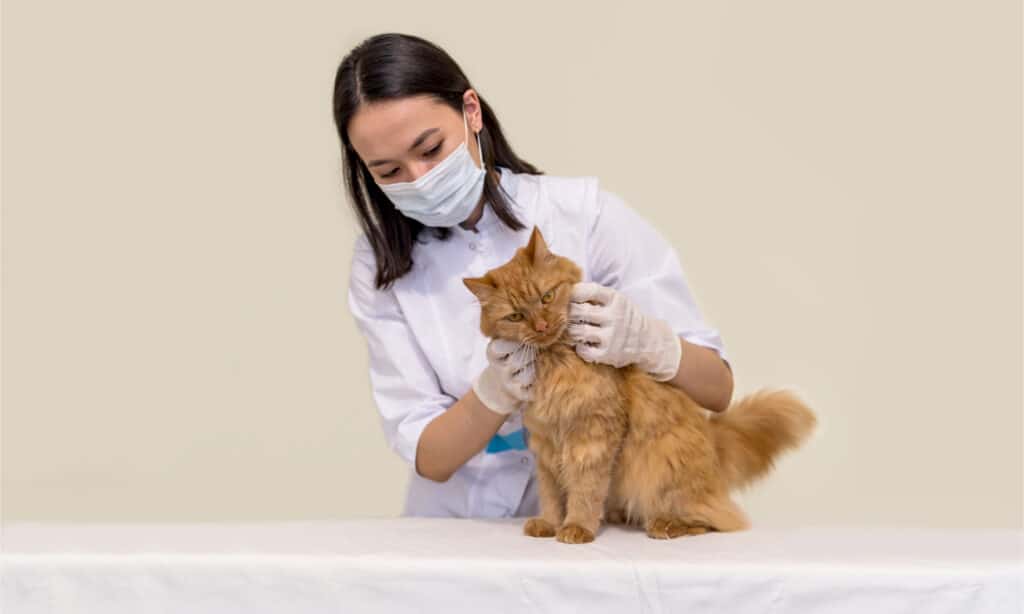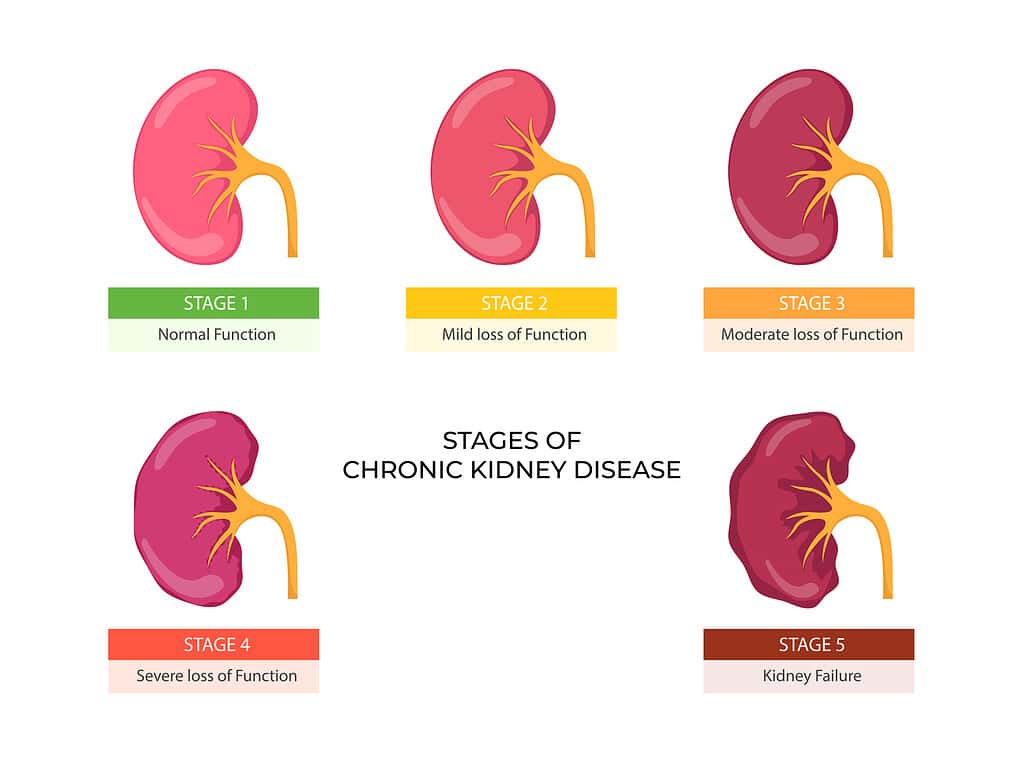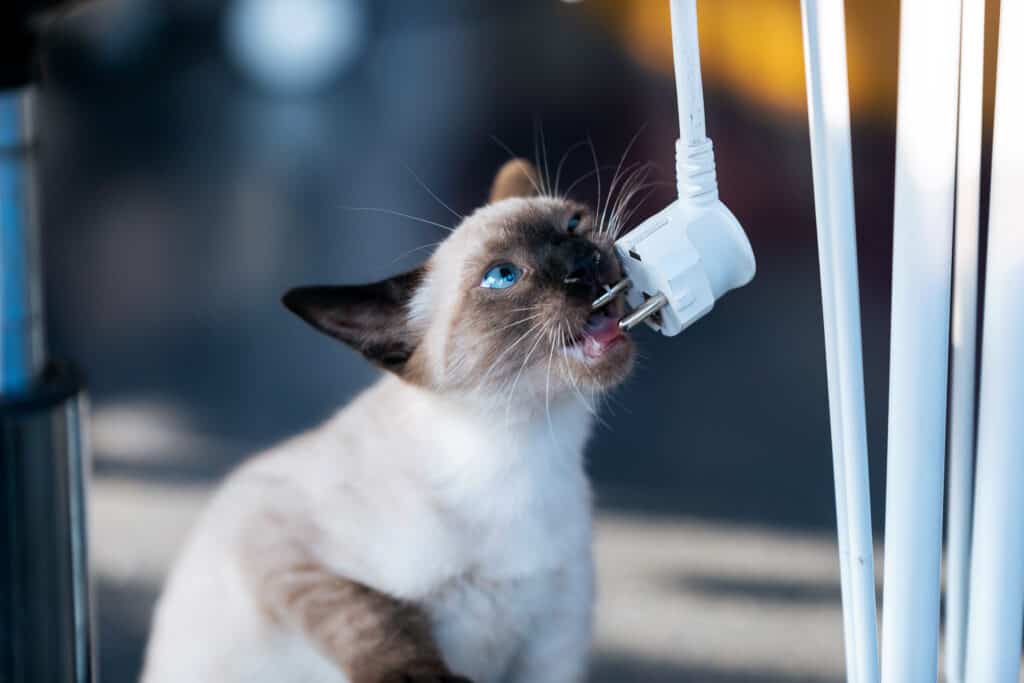
Only veterinarians should decide if it’s safe to use famotidine for your cat.
©Irzhanova Asel/Shutterstock.com
This histamine H2 receptor decreases the production of stomach acid. It does this by binding to the receptors within the stomach that instruct it to create acid. Essentially, it blocks them from making acid for a period of time.
Famotidine is widely considered safe for use in humans, cats, dogs, and horses. However, as with any medication, it is essential to consult your veterinarian before giving it to your kitty. According to the Federal Drug Administration (FDA), using famotidine in cats, dogs, and small mammals to treat ulcers is “off-label.” This means the drug has not been approved for this purpose, but veterinarians may choose to use it anyway. Off-label prescriptions are allowed in veterinary medicine because it’s covered under extra-label drug use (ELDA).
Dr. Julie Parks, a Doctor of Veterinary Medicine at Northwood Hills Animal Hospital, told AZ Animals, “Famotidine is an over-the-counter drug we primarily use to treat gastric ulcers. Occasionally, for pets that are very sensitive to non-steroidal anti-inflammatory drugs, we use famotidine to help prevent ulcers. We hardly ever see side effects.” On another note, one study concluded that prolonged use of famotidine in cats reduces its effectiveness.
Let’s read on to learn about the possible side effects, dosage, and more of famotidine in cats.
What is Famotidine Used for in Cats?
Because famotidine reduces the production of stomach acid, it has many uses in cats. This is especially true for cats suffering from problems with their gastrointestinal system. The gastrointestinal system includes all the body parts used to eat and process food — the mouth, esophagus, stomach, and intestines.
Famotidine can be given to cats by mouth, intravenously (injected into a vein), or intramuscularly (injected into the muscle). Veterinarians must use caution when giving this drug intravenously because giving it too quickly can cause vomiting and irregular heartbeat (arrhythmia).
Let’s learn about the most common uses of famotidine in cats!
Stomach Ulcers
A stomach ulcer occurs when the natural acid within it erodes (breaks down) the protective lining. This condition causes a burning sensation in the stomach and may lead to nausea, vomiting, and reduced appetite. Because cats are so sensitive to going without food, inappetence (not wanting to eat or not feeling hungry) becomes a major concern quickly.
A cat that doesn’t eat for just 48 hours is subject to fatty liver syndrome (hepatic lipidosis). This condition is an absolute emergency! Cats refusing to eat may require intensive care hospitalization with intravenous fluids and even a nasogastric feeding tube. This is a thin rubber tube placed through the nose and into the stomach by your veterinarian while your cat is sedated. It allows food to be passed directly into the stomach.

Drooling can be a sign of nausea in cats.
©Schearbl/iStock via Getty Images
Stomach Inflammation Secondary to Kidney Disease
Nearly all senior cats (those over 8 years old) will experience kidney disease at some part of their life.
Unfortunately, a symptom of this reduced kidney function can be inflammation within the stomach. Just like with ulcers, this can cause nausea, vomiting, and inappetence. Veterinarians may choose to administer this medication to help with the symptoms of these stomach problems. Famotidine used in this manner may also encourage cats to continue eating since it will help soothe their aching stomach.

Many cats experience at least some degree of kidney disease as they age.
©agung fatria/iStock via Getty Images
Esophageal Ulceration or Inflammation
Famotidine is used in cats to soothe the irritated, inflamed, or ulcerated esophagus. The esophagus is the part of the throat that carries food from the mouth into the stomach. Occasionally, it can become inflamed or even develop an ulcer.
Although very rare, inflammation of the esophagus can occur after surgery that requires the cat to be intubated. Intubation is when a breathing tube is inserted into the trachea (the part of the throat that carries air in and out of the lungs). This tube delivers anesthesia (sleeping gas) and oxygen to the patient during surgery. Because the trachea and esophagus sit so closely together, some inflammation can occur during intubation. For most cats, this inflammation goes away on its own. However, some cats are more sensitive than others.
Other times this problem can occur with repetitive vomiting, acid reflux, or from some medications such as doxycycline. Doxycycline capsules and tablets can damage the esophagus if they begin to dissolve before reaching the stomach. For this reason, following doxycycline with a small amount of water from a syringe is highly recommended by most veterinarians.
Another possible cause is electrocution. When kittens or cats play with electrical wires and bite into them, they can get electrocuted. This painful accident usually causes burns in the mouth and throat. Famotidine may be used for cats in this predicament. Veterinarians may use sucralfate in combination with famotidine because of its ability to coat the mouth, throat, and stomach which helps relieve the pain of the burns.

Never let your cat play with electrical cords. This can lead to electrocution and severe burns in the mouth and throat.
©iStock.com/nensuria
Side Effects of Famotidine in Cats
The most common side effect (though still quite rare) of famotidine use in cats is diarrhea. In human trials, side effects such as vomiting, inappetence, headache, dry mouth, and dry skin occurred. Extremely rarely, low white blood cell count occurs in cats on famotidine.
Remember, if you think your cat is having a side effect of any medication, the best thing to do is call your veterinarian right away!
When Should Cats Not Take Famotidine?
In elderly pets, famotidine should be used at a reduced dose and with caution. This mostly pertains to intravenous injections, but pets with heart disease should be closely monitored. Any cats already experiencing liver or kidney disease should take famotidine only with careful observation, as well.
Dosage Chart for Famotidine in Cats
Always follow your veterinarian’s instructions exactly and finish the prescribed course unless otherwise instructed, even if your cat appears to be feeling 100% better.
The typical famotidine dose for cats is 5 mg every 12 to 24 hours. If your cat must take famotidine for an extended period, your veterinarian will likely instruct you to use the minimum effective dose (MED). MED is the least amount of drugs a patient can take and still experience the desired results. Some studies report famotidine is not very effective in cats. If the medication you are prescribed for your cat isn’t helping, contact your veterinarian to discuss next steps.
Famotidine for cats should be given on an empty stomach at least 30 minutes before any food or other medications. The best results occur with dosing before the first meal of the day. If your cat becomes nauseous or vomits after taking famotidine, you can try giving it with a small amount of food or a treat.
If your cat is unable or unwilling to take pills, liquid famotidine may be available. Is liquid medication still not an option for your kitty? No problem! Your veterinarian is able to administer famotidine intravenously or intramuscularly. These dosage forms are especially useful for very nauseous or vomiting cats.
| Cat’s Weight in Pounds | Famotidine Dosage |
|---|---|
| All Weights | 5 mg per dose |
Final Thoughts on Famotidine for Cats
Famotidine for cats is useful in preventing or treating stomach and esophageal ulcers or inflammation. Very rarely, cats may experience side effects when taking famotidine. Most side effects are mild and non-life threatening. As always, owners should never give a cat any medication without first discussing it with their veterinarian.
The photo featured at the top of this post is © New Africa/Shutterstock.com
Thank you for reading! Have some feedback for us? Contact the AZ Animals editorial team.







